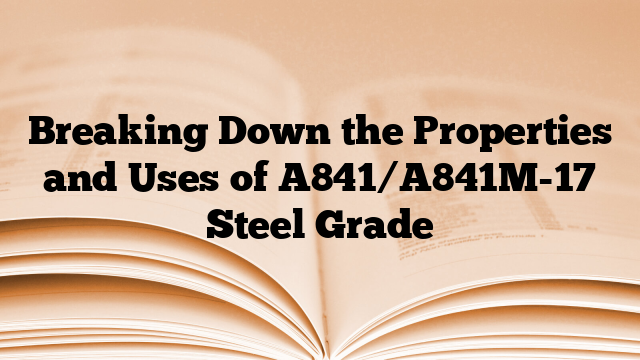Breaking Down the Properties and Uses of A841/A841M-17 Steel Grade
The A841/A841M-17 steel grade is a specification for pressure vessel plates, alloy steel, and high-strength, quenched and tempered steel intended for use in fusion welded boilers and other pressure vessels. This steel grade is usually produced in thicknesses ranging from 6-100mm.
Mechanical Properties:
– Tensile Strength: The A841/A841M-17 steel grade has a minimum tensile strength of 515-690MPa.
– Yield Strength: The minimum yield strength of this steel grade is 345MPa.
– Elongation: The A841/A841M-17 steel grade has a minimum elongation of 20%.
Chemical Composition:
The chemical composition of A841/A841M-17 steel grade includes elements such as carbon, manganese, phosphorus, sulfur, silicon, copper, nickel, chromium, molybdenum, and aluminum. The maximum carbon content is 0.15%, manganese content is 0.90%, phosphorus content is 0.025%, sulfur content is 0.010%, silicon content is 0.15-0.50%, copper content is 0.35%, nickel content is 0.07%, chromium content is 0.10-0.40%, molybdenum content is 0.10%, and aluminum content is 0.015%.
Uses:
The A841/A841M-17 steel grade is primarily used in the construction of large-scale pressure vessels, especially those that operate at high temperatures and require high-strength materials. These pressure vessels may be used in various industries, including oil and gas, chemical, and power generation. The high strength and tough nature of this steel grade make it suitable for withstanding high internal pressures and harsh operating conditions.
Standard Number:
The A841/A841M-17 steel grade is designated by the ASTM International standard number A841/A841M-17. This standard provides the specifications and requirements for the manufacturing and testing of pressure vessel plates made from this steel grade.
Corresponding Grades:
A841/A841M-17 steel grade may have corresponding grades in other international standards, such as EN, ISO, or JIS. It is important to consult the relevant standards and compare the chemical composition and mechanical properties to ensure compatibility and suitability for specific applications.

